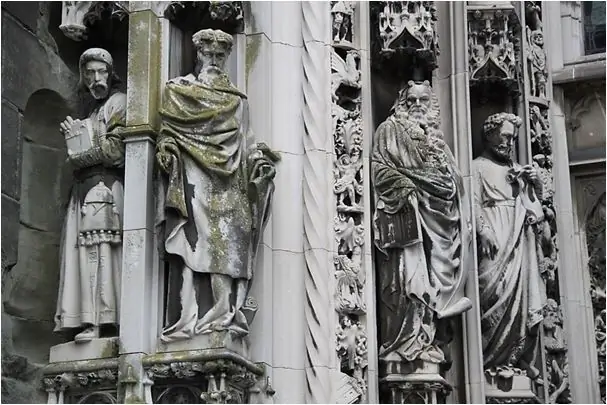- Author Antonio Harrison [email protected].
- Public 2023-12-16 07:44.
- Last modified 2025-01-22 21:44.
The Bible is an ancient book, sacred to any Christian, be it Orthodox, Catholic or Protestant. Every word of her is sacred, and such an attitude arouses the desire to perpetuate the biblical texts. It is difficult to find a more suitable material for this than stone.

The idea of perpetuating sacred texts in stone is presented in the Bible itself. According to the biblical book of Exodus, the ten commandments given by God to the prophet Moses were inscribed precisely on the tablets - stone slabs. The tablets of Moses, even if they existed in the form described in the Bible, have not survived. But the very idea of carving Holy Scripture in stone has been embodied more than once.
Sculpture
A Bible in stone is not necessarily a text. The "Stone Bible" is often called the sculptures that adorn the cathedrals of medieval Europe. However, "decorating" is not a completely accurate definition, because the main purpose of their creation was by no means beauty. In the Middle Ages, even kings and noble lords could not read, not to mention ordinary townspeople and peasants. In such conditions, sculptural compositions depicting biblical heroes were the only (along with listening to sermons) way to get acquainted with the content of Scripture.
However, the presence of such sculptures in Europe is not surprising. But the most ancient monument of this kind was found in a country that can in no way be called Christian - in China.
Christianity did not become the dominant religion in China, nevertheless, it penetrated there already in the 1st century AD. The tomb found by archaeologists in Jiang-Su, a province in eastern China, dates back to this era. Various scenes from the Bible are carved on the walls of the tomb: the creation of the world, the temptation of the progenitor Eve, the birth of Jesus Christ, episodes from the acts of the apostles.
Book and stele
It is extremely difficult for a modern person to imagine a stone book, nevertheless, it exists. The "book", in which the role of pages is played by heavy stone slabs, was discovered in the high-mountainous village of Tsebelda, located in the Gurlypsh region of Abkhazia. Of course, it was impossible to embody the Bible in its entirety in stone, an unknown master carved only 20 plots, but even in this form, the stone Bible makes an impression. This unusual book is located in the capital of Georgia, Tbilisi, in the State Museum of Art.
To a certain extent, a historical monument is in contact with the idea of a “stone Bible”, which has no direct relation to the Bible, but indirectly confirms the reality of the events described in it.
In 1868, F. Klein, a missionary from Alsace, found a stele in Diban (the territory of modern Jordan), which was called the Moabite stone, or the Mesh stele. The inscription on the stone narrated about the exploits of the Moabite king Mesh, who conquered Moab from the Israeli king Omri (the biblical Omri). The inscription also mentions Ahab, the son of Omri, the God Yahweh, revered by the Israelites, and the Israelite tribe of Gad. Unfortunately, the Mesh stele has not survived; a year after its discovery, the local Arab inhabitants smashed it.






